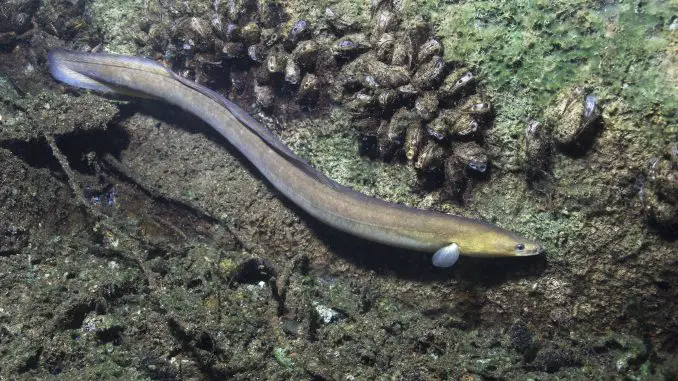
If you are looking for a large and unique tank addition, the Fire Eel might be just the fish you are looking for. The Fire Eel is not a true eel, but a freshwater fish that is called an eel due to its appearance.
Fire Eel are huge specimens, so you’ll need a larger-than-normal tank to accommodate them, but they do bring a distinct vibe to your aquarium, so if you have the room to house one, you might find it worth the space invested.
We will cover everything you need to know before adding a Fire Eel into your aquarium community, from natural habitat and history to appearance and behavior to optimal conditions to diet and habitat requirements. Read on to see if the Fire Eel is the right fish for you!
TABLE OF CONTENTS
Fire Eel Facts & Overview
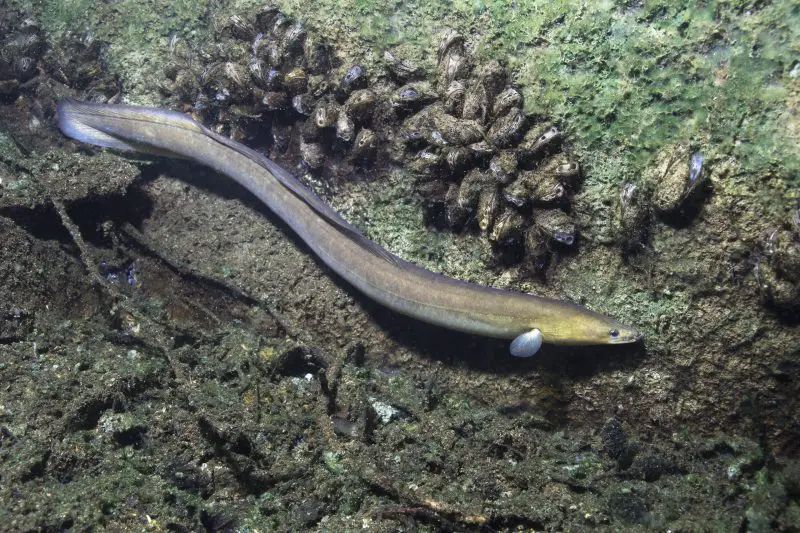
| Category | Rating |
| Care Level: | Easy |
| Temperament: | Predatory |
| Color Form: | Brown with red or orange |
| Lifespan: | 10 years |
| Size: | 20 inches |
| Diet: | Omnivore; bottom feeder |
| Family: | Mastacembelidae |
| Minimum Tank Size: | 80 gallons |
| Tank Set-Up: | Freshwater with plants and rocks |
| Compatibility: | Peaceful but predatory |
Fire Eels, the scientific name Mastacembelus erythrotaenia, are freshwater fish native to the river beds of Southeast Asia. Although it is not a true eel, it shares the snake-ish appearance of eels and is one of the larger aquarium inhabitants.
One important thing to recognize about Fire Eels is that there is quite a difference between Fire Eels that live in the wild and those that live in home aquariums. You can expect the Fire Eel in your home tank to grow to about 20 inches (60.8 cm) and live for about 10 years with proper care. In their natural habitat, however, Fire Eels grow to 3.3 feet (about 1 meter) and live twice as long – about 20 years!
Clearly, Fire Eels are more likely to thrive in the wild. However, in the wild, they are also more likely to be chosen for a human snack, as Fire Eels are considered to be a delicacy in Southeast Asia. Locals in Cambodia, Indonesia, Laos, Malaysia, Myanmar, Pakistan, and Vietnam enjoy feasting on Fire Eels.
Local fishermen would tell the hobbyist to handle Fire Eels with care since their sharp spines emit a toxic slime that you do not want to experience.
Fire Eels are true diggers and burrowers, and in their natural habitat enjoy the slow currents of lakes and rivers, where they happily nest in the mud.
Typical Behavior
Fire Eels are nocturnal creatures and prefer to hide during the day, so they will appreciate lots of hiding places–aquarists should note that the regular decorations, rocks, and small aquatic plants will not suffice for these 20-inch eels.
You will need large pieces of driftwood, larger rocks, or maybe some PVC pipe to give these guys appropriate hiding space. It is also a good idea to keep the lighting dim.
As we mentioned in the previous section, Fire Eels enjoy digging and burrowing, so go easy on rooted aquatic plants like Dwarf Sagittaria, or they will uproot it all and destroy your substrate. Stick to Guppy Grass or other floating aquatic plants.
The feeding behavior of Fire Eels is peculiar: it has a growth on the end of its nose that it uses to canvas the bottom of the tank for food. At the end of the growth on his nose, there are two nostril tubes. It’s truly an unforgettable look.
If you happen to be enjoying a view of your tank during the day and see a long nose and huge eyes sticking out of the substrate, that’s just your Fire Eel doing some daytime burrowing.
Appearance
Covered with scales, the Fire Eel’s long, snakelike body is dark brown with 4 stripes placed laterally. These stripes have either red or orange hues and have spots that vary depending on the age of the eel and the condition of your tank.
The dorsal fin of the Fire Eel is divided into two parts, and it has a tail that is fully developed. The dorsal and anal fins are long and narrow and located near the end of the caudal fin. Interestingly, Fire Eels have no abdominal fins.
In terms of size, you can expect your Fire Eel to reach a maximum length of 20 inches (60.8 cm); if they were in the wild, they would be much bigger, reaching a length of 3.3 feet, or about a meter.
Even at 20 inches, the Fire Eel is one of the largest spiny eels in the aquarium hobby. There are a couple of theories about why the Fire Eel does not get to be as large in captivity. One is that it is difficult to recreate the water conditions that the eels have in their natural habitat; the other is that even with a very large home aquarium, there is not enough room for that kind of growth.
Male and Female Characteristics
It is possible to discern between female and male Fire Eels. The male is more brightly colored and is a little thinner. The female, on the other hand, has a dull hue and is larger. The differences are easier to spot during breeding when the male’s color becomes even more intense.
Habitat and Tank Conditions
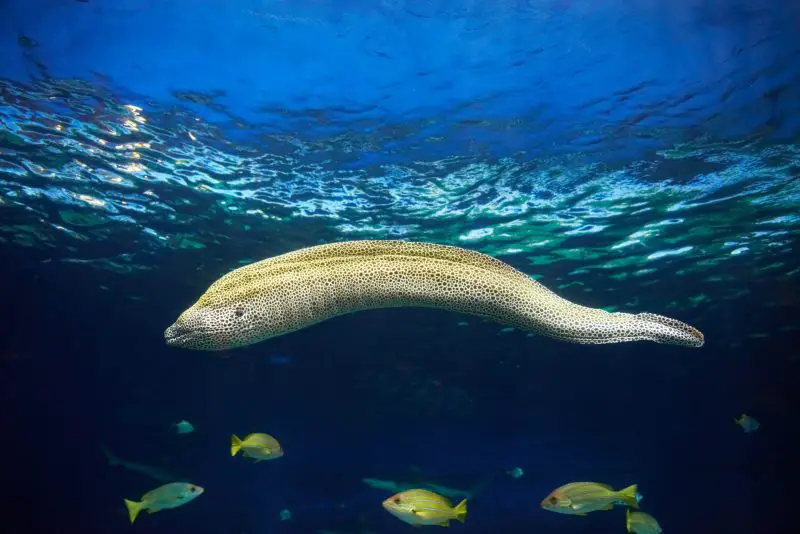
Because the Fire Eel grows to be so large, you will need an 80-gallon tank at a minimum, or about 350 liters. Fire Eels grow quickly, so don’t expect to be able to start out with a smaller tank and then upgrade–they need the space immediately.
For optimal quality of life, it is best to recreate the conditions that Fire Eels have in the wild. Even if they are bred in captivity, they still have the internal wiring for the same kind of environment. In their natural habitat in Southeast Asia, they burrow in the mud, so endeavor to create a muddy area.
The substrate should be thick since they like to dig–aim for 2 inches of fine sand, or 5 cm. Make sure it is fine so that it does not damage or scratch this bottom dweller.
Again, plentiful hiding places are a must for Fire Eels, and you should avoid rooted plants, opting instead for floating plants that they can not dig up. Because they are nocturnal, lighting should be dim, so the floating plants will help filter out bright light.
In addition to large driftwood and rocks, you could turn a flower pot on its side; your Fire Eel will happily seek refuge inside.
You also want to make sure that your tank has a tight-fitting lid since the Fire Eel is a bit of a Houdini and might very well escape if the lid is loose or absent.
Fire Eels need constant water flow that is well oxygenated. To ensure optimal conditions for your Fire Eel, perform regular water changes, and make sure you have a strong filter because Fire Eels like water that is very clean.
Water Conditions
As a result of their natural habitat in Southeast Asian lowland rivers, Fire Eels can tolerate myriad water parameters. Their ideal parameters are:
- Temperature: 75-82°F (24-28°C)
- pH: 6.0 to 7.5.
- GH: 6-12
What Size Aquarium Do They Need?
Fire Eels require a minimum tank size of at least 80 gallons, about 350 liters.
How Many Can Be Kept Per Gallon?
For one Fire Eel, you will need a tank that is 80 gallons.
Tank Mates
Although the Fire Eel is a peaceful fish, it is still a predatory creature. Fire Eels will not bother larger fish in the tank but will eat fish that are smaller than they are.
Suitable tank mates for Fire Eels
- Angel Fish
- Barbs (medium to large)
- Green Terror
- Oscar Fish
Keeping Fire Eels Together
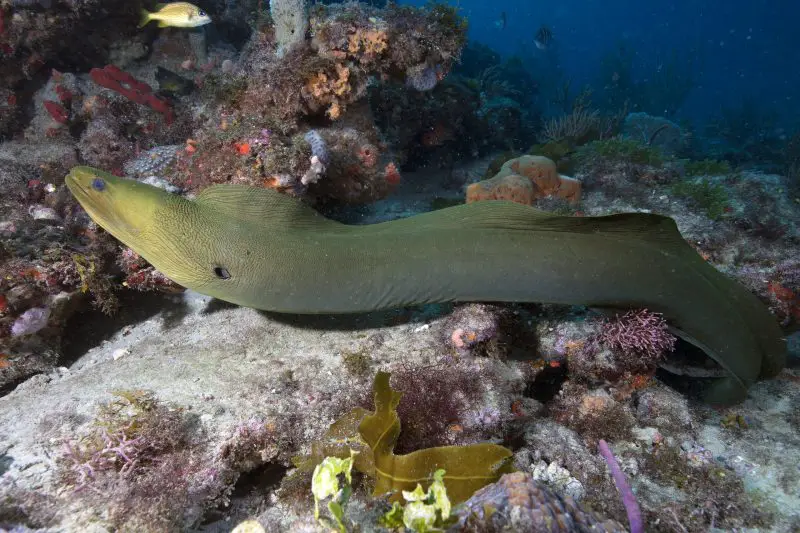
Fire Eels are quite aggressive and should not be kept in a tank together. Putting them together will endanger the Fire Eels and create a stressful aquarium environment that will be detrimental to all the aquarium inhabitants.
Diet
In their natural habitat in Southeast Asian rivers, Fire Eels prey on small crabs, insect larvae, snails, and worms. In a home aquarium, Fire Eels recognize their owners and will accept food from their hands. This is a significantly more satisfying experience than dropping pinches of flakes into a tank.
You can feed Fire Eels live food, such as bloodworms, small fish, and tubifex; they will also be happy with dry and frozen food.
Although Fire Eels are omnivores, they go after meaty sources of protein first.
Younger Fire Eels do well with invertebrates such as bloodworms and brine shrimp. Adult Fire Eels can handle larger food like earthworms, fish, mussels, and live shrimp.
Good sources of nutrition for Fire Eels
- Bloodworm
- Crabs
- Insect Larvae
- Small Fish
- Snails
- Tubifex
- Worms
One important thing to remember is that because the Fire Eel is so large, it requires more nutrition, so make sure you are feeding it enough. You will see the benefits of proper nutrition in the Fire Eel’s increased activity and more intense hues.
Care
The best care for Fire Eels is not too different than caring for other aquarium fish. Make sure to keep their tank clean by performing regular water changes and using a quality filter. Do regular tests to make certain that the water parameters are at the recommended levels so that your Fire Eel can thrive.
Reduce stress on your Fire Eel by providing enough space–this is really key for a healthy fish and maximizes its chances of longevity.
Other things that will lead to a stress-free life for your Fire Eel include:
- Keeping them away from other Fire Eels. Although these fish are pretty docile, they get super aggressive around their own kind.
- Give them plenty of places to hide. They come out of hiding at night but need places of refuge during the day.
- Provide sufficient nutrition: big fish need lots of food. They also crave that connection with their owner and like to be hand-fed. (We think you’ll crave that connection with your Fire Eel, too!)
- Make sure they have space to dig and burrow. Ensuring at least 2 inches of fine sand will give them sufficient space to dig in the sand.
- Muddy the waters. Well, the water itself needs to be clean, but Fire Eels hang out in the mud when they are in their natural habitat. If you can recreate some mud-like conditions in your tank, Fire Eels will be content.
It’s unfortunate that Fire Eels in the home aquarium have a much shorter lifespan than Fire Eels that live in the wild. Since they will be with you for a shorter time, it is important to provide them with the highest quality of life with proper care.
Diseases
You should always be on the lookout for any diseases your eel may have picked up. Changes in their behavior or markings on their body should give it away.
The earlier you notice an issue, the quicker you can respond.
Many common freshwater diseases that can affect your other fish can also affect your Fire Eel. The most well-known is ich (White Spot Disease) which is a parasite that causes white spots to appear across the eel’s body.
There are medications available from stores for these kinds of things.
Bacterial diseases often become a problem for your Fire Eels; they are quite common for all spiny eels like these.
Some are harder to treat than others, so taking preventative measures is always the best option, to avoid these issues in the first place.
This means putting in the extra effort to increase the frequency of things like partial water changes, to keep the environment as clean as possible.
Infections are often caused by rough substrate; Fire Eels spend so much time around the substrate that large grains can scratch them.
This can explain why some Fire Eels develop a white nose, since they have been using it to bury into a coarse substrate.
Create a thick layer of a sandy/muddy substrate.
Breeding
If you have the inclination of attempting the daunting task of breeding Fire Eels, you should know that we do not recommend breeding in captivity. First of all, Fire Eels do not do well when they are together in a tank, so bringing two together for mating will be tumultuous. Second, you will need a lot of space for both the regular tank and the breeding tank.
Finally, it’s difficult to recreate the environment in the wild necessary for spawning, and, therefore, attempts to breed are likely to be fruitless.
During breeding, the male chases the female until he catches her, at which point he squeezes 700 to 1000 eggs out of her. Adult Fire Eels are likely to eat their own eggs, so if you are attempting to breed, you should remove the parents immediately after egg-laying.
Are Fire Eels Suitable for your Aquarium?
It’s true that Fire Eels require a significant amount of real estate. However, if you’re up to the challenge, they can be a rewarding addition to your community aquarium, and when they come out of hiding at night, they surely stand out in the tank.
Is Fire Eel your favorite big fish? Leave a comment about what you love about Fire Eels


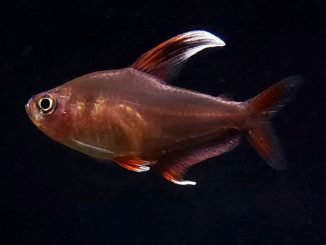
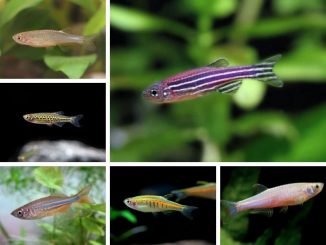
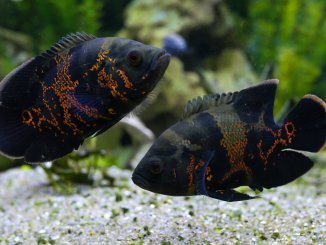
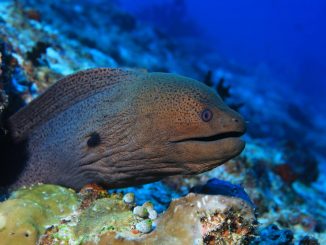
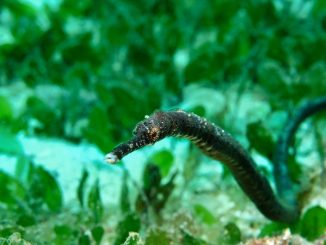
Got my first fire eel about seven weeks ago. It was already about 20 inches when I got it. I have 180 gallon African Cichlid tank. What a blast having him although I think it’s her FaceTime descriptions at the females are bigger. My fish is definitely a glutton when it comes to eating. The only thing my fire it will eat his life earthworms I just don’t know how many to give even if I give 8 at a feeding every day it doesn’t seem to be enough to satisfy the appetite. What’s amazing I was told this fish Would hide all the time and only come out for feedings but I get to enjoy whenever I’m in front of the tank he comes out looking for food and even when I feed him he probably stays out swimming for a good hour or two. We’re approaching 23 inches in size
I have my first fire eel about 3 months now. It is about 21 to 23 inches long. Very healthy appetite and will only eat night crawlers. The question is how many. I don’t want to over feed but also don’t want to underfed. The eel easily eats 9 or 10 at a single feeding and I feel it might be too much
Thank you.
For the size of your eel that is the appropriate amount to feed them you can feed them as many as 12 in a feeding.
Just got what I think is a Fite eel.Came in to a fish store with some kulli loaches. The store called me to ID.ITS ONLY 3 INCHES.